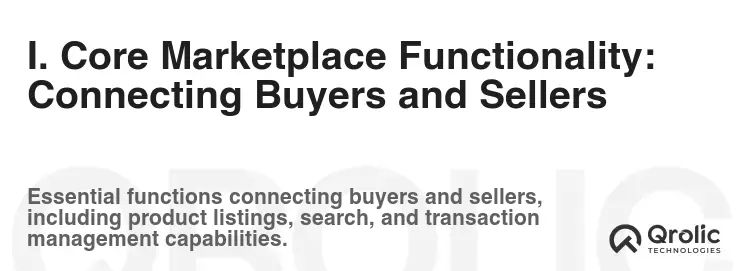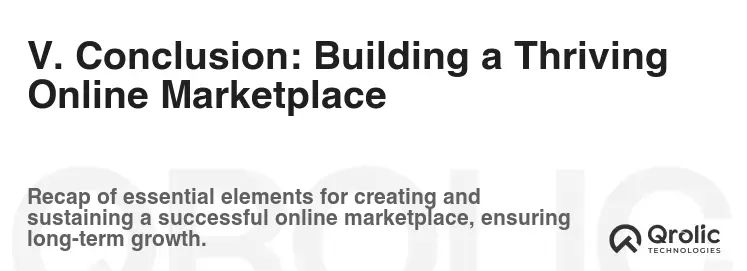Building a successful online marketplace is a complex undertaking. It requires more than just a visually appealing website. You need a carefully crafted platform with features designed to attract both buyers and sellers, fostering trust and driving transactions. This comprehensive guide explores the essential website features that will elevate your online marketplace and set you apart from the competition.
Quick Summary:
- Offer robust product listings and easy search.
- Provide secure payments and smooth checkout.
- Empower sellers with intuitive tools and support.
- Boost growth using personalization, reviews, and SEO.
Table of Contents
- I. Core Marketplace Functionality: Connecting Buyers and Sellers
- A. Robust Product Listings: Showcasing Value and Information
- B. Seamless Search Functionality: Helping Buyers Find What They Need
- C. Secure and Diverse Payment Gateways: Building Trust and Convenience
- D. Streamlined Checkout Process: Reducing Cart Abandonment
- II. Enhancing the Seller Experience: Empowering Your Vendors
- A. User-Friendly Seller Dashboard: The Control Center
- B. Seller Communication and Support: Building a Thriving Community
- C. Commission and Payout Management: Transparency and Efficiency
- III. Advanced Features for Growth and Differentiation
- A. Personalized Recommendations: Enhancing the Shopping Experience
- B. Reviews and Ratings System: Building Trust and Social Proof
- C. SEO-Friendly Platform: Attracting Organic Traffic
- D. Mobile App: Expanding Reach and Engagement
- IV. Qrolic Technologies: Your Partner in Marketplace Success
- V. Conclusion: Building a Thriving Online Marketplace
I. Core Marketplace Functionality: Connecting Buyers and Sellers

A. Robust Product Listings: Showcasing Value and Information
High-Quality Images and Videos:
- What: The cornerstone of any appealing product listing. High-resolution images from multiple angles and engaging product videos are crucial.
- Why: Visuals directly impact purchase decisions. Clear images build trust and allow customers to examine details. Videos showcase product functionality and lifestyle integration.
- How:
- Professional Photography: Invest in professional product photography for optimal results.
- Multiple Angles: Capture products from various perspectives (front, back, sides, details).
- Lifestyle Shots: Show products in use to help buyers visualize ownership.
- 360-Degree Views: Consider interactive 360-degree views for enhanced product exploration.
- Video Demos: Create short, informative videos showcasing key features and benefits.
- Example: Amazon employs high-quality images and videos on product pages, often including user-submitted content.
- SEO Benefit: Image alt text and video descriptions are excellent opportunities to include relevant keywords (e.g., “leather handbag,” “portable Bluetooth speaker demo”).
Detailed Product Descriptions:
- What: Comprehensive and informative descriptions that leave no question unanswered.
- Why: Descriptions provide essential product information, address potential concerns, and enhance SEO.
- How:
- Key Features and Benefits: Clearly outline what the product does and how it benefits the buyer.
- Technical Specifications: Include relevant technical details (dimensions, materials, weight, power requirements).
- Use Cases: Suggest various ways the product can be used.
- Warranty and Return Information: Transparently state warranty details and return policies.
- Compelling Language: Use persuasive language to highlight the product’s unique selling points.
- Example: Etsy relies on detailed descriptions provided by sellers to convey the unique story and craftsmanship behind their handmade items.
- SEO Benefit: Use long-tail keywords and variations to target specific search queries (e.g., “handmade leather tote bag with adjustable straps,” “high-resolution 4K webcam for video conferencing”).
Product Categorization and Filtering:
- What: A structured system for organizing products into categories and subcategories, coupled with robust filtering options.
- Why: Enables users to quickly and easily find the products they’re looking for.
- How:
- Logical Categories: Create categories that are intuitive and easy to understand.
- Granular Subcategories: Break down categories into more specific subcategories.
- Comprehensive Filters: Offer filters based on price, size, color, brand, features, and other relevant attributes.
- Dynamic Filtering: Ensure filters update dynamically based on the available products in the selected category.
- Example: eBay’s advanced filtering system allows users to narrow down their search based on a multitude of criteria, from condition to delivery options.
- SEO Benefit: Optimized category pages with keyword-rich descriptions can rank highly in search results (e.g., “women’s running shoes,” “vintage record players”).
B. Seamless Search Functionality: Helping Buyers Find What They Need
Advanced Search Bar:
- What: More than a simple keyword search. Includes features like auto-suggestions, spell correction, and search history.
- Why: Improves search accuracy and user experience, leading to faster product discovery.
- How:
- Autocomplete Suggestions: Suggest relevant keywords and products as users type.
- Spell Correction: Automatically correct typos to ensure accurate search results.
- Search History: Allow users to easily revisit previous searches.
- Synonym Recognition: Recognize and understand synonyms for improved search relevancy.
- Example: Google’s search bar is a benchmark for advanced search functionality, incorporating all of the features listed above.
- SEO Benefit: Analyze search queries to identify popular product keywords and optimize product listings accordingly.
Search Filters and Sorting:
- What: Tools that allow users to refine search results based on various criteria (price, ratings, popularity, etc.).
- Why: Empowers users to quickly find the most relevant products within a vast selection.
- How:
- Price Range Filter: Allow users to specify a desired price range.
- Rating Filter: Allow users to filter products based on average customer rating.
- Sorting Options: Offer sorting options based on price (low to high, high to low), popularity, relevance, and newness.
- Example: Amazon utilizes a comprehensive filtering system on search results pages, allowing users to narrow down their search based on numerous attributes.
- SEO Benefit: Optimize product listings for relevant long-tail keywords that users are likely to use in their searches.
Voice Search Optimization:
- What: Adapting your marketplace to accommodate voice searches, which are increasingly popular.
- Why: Caters to the growing trend of voice search and improves accessibility for users.
- How:
- Optimize for Conversational Keywords: Use natural language and conversational phrases in product descriptions and content.
- Structured Data Markup: Implement schema markup to help search engines understand the context of your content.
- Mobile Optimization: Ensure your marketplace is optimized for mobile devices, as most voice searches are conducted on mobile.
- Example: Companies like Walmart are increasingly investing in voice search optimization to cater to the growing number of voice-enabled devices.
- SEO Benefit: Targeting long-tail, conversational keywords that are commonly used in voice searches.
C. Secure and Diverse Payment Gateways: Building Trust and Convenience
Multiple Payment Options:
- What: Offering a variety of payment methods to cater to different customer preferences.
- Why: Increases conversion rates by providing customers with their preferred payment options.
- How:
- Credit/Debit Cards: Accept major credit and debit cards (Visa, Mastercard, American Express, Discover).
- Digital Wallets: Integrate with popular digital wallets (PayPal, Apple Pay, Google Pay).
- Local Payment Methods: Offer local payment methods specific to your target markets (e.g., iDEAL in the Netherlands, Alipay in China).
- Buy Now, Pay Later (BNPL): Consider offering BNPL options like Afterpay or Klarna.
- Example: Shopify integrates with a wide range of payment gateways to cater to diverse customer preferences.
- SEO Benefit: While not directly SEO-related, offering diverse payment options improves user experience and conversion rates, indirectly contributing to higher rankings.
Secure Payment Processing:
- What: Implementing robust security measures to protect sensitive customer data during payment transactions.
- Why: Builds trust and ensures the safety of customer financial information.
- How:
- SSL Encryption: Use SSL encryption to secure all data transmitted between the user’s browser and the server.
- PCI DSS Compliance: Comply with the Payment Card Industry Data Security Standard (PCI DSS) to ensure the security of credit card data.
- Fraud Prevention: Implement fraud detection and prevention measures to protect against fraudulent transactions.
- Tokenization: Use tokenization to replace sensitive data with non-sensitive tokens.
- Example: Stripe is a popular payment gateway that prioritizes security and PCI DSS compliance.
- SEO Benefit: Secure websites are favored by search engines. Implementing SSL encryption is a ranking signal.
Escrow Services:
- What: A third-party service that holds payment until the buyer confirms satisfaction with the product.
- Why: Provides an extra layer of security and trust, especially for high-value transactions.
- How:
- Buyer Pays Escrow: The buyer sends payment to the escrow service.
- Seller Ships Product: The seller ships the product to the buyer.
- Buyer Inspects Product: The buyer inspects the product and confirms satisfaction.
- Escrow Releases Payment: The escrow service releases payment to the seller.
- Example: Many online marketplaces that facilitate the sale of used goods or high-value items offer escrow services.
- SEO Benefit: Trust signals, like offering escrow services, can indirectly improve your website’s reputation and ranking.
D. Streamlined Checkout Process: Reducing Cart Abandonment
Guest Checkout Option:
- What: Allows users to make purchases without creating an account.
- Why: Reduces friction in the checkout process and can increase conversion rates.
- How:
- Offer Guest Checkout as Default: Make guest checkout the default option and allow users to create an account later if they choose.
- Minimal Information Required: Only ask for essential information needed to process the order.
- Example: Many e-commerce platforms offer guest checkout as a standard feature.
- SEO Benefit: Faster checkout processes lead to higher conversion rates and improved user engagement, which can positively impact SEO.
Clear and Concise Checkout Steps:
- What: A well-defined and easy-to-follow checkout process.
- Why: Reduces confusion and prevents users from abandoning their carts.
- How:
- Progress Indicator: Display a progress indicator to show users where they are in the checkout process.
- Clear Error Messages: Provide clear and helpful error messages if users make a mistake.
- Order Summary: Display a clear order summary before users submit their order.
- Example: Amazon’s checkout process is renowned for its simplicity and clarity.
- SEO Benefit: A streamlined checkout process improves user experience and reduces bounce rates, both of which are positive signals for search engines.
Mobile-Optimized Checkout:
- What: Ensuring the checkout process is fully optimized for mobile devices.
- Why: A significant portion of online transactions are now conducted on mobile devices.
- How:
- Responsive Design: Use responsive design to ensure the checkout process adapts to different screen sizes.
- Large Buttons and Text: Use large buttons and text to make it easy for users to interact with the checkout process on mobile devices.
- Simplified Forms: Simplify forms and use auto-fill features to reduce typing on mobile devices.
- Example: Shopify provides mobile-optimized checkout templates for its users.
- SEO Benefit: Mobile-friendliness is a crucial ranking factor. A mobile-optimized checkout process improves user experience on mobile devices and boosts SEO.
II. Enhancing the Seller Experience: Empowering Your Vendors

A. User-Friendly Seller Dashboard: The Control Center
Intuitive Interface:
- What: A clean, organized, and easy-to-navigate dashboard for sellers.
- Why: Reduces the learning curve and empowers sellers to manage their listings and orders efficiently.
- How:
- Clear Navigation: Use clear and concise labels for all menu items and sections.
- Logical Organization: Organize information logically and group related tasks together.
- Visual Hierarchy: Use visual cues (e.g., headings, subheadings, icons) to guide users’ attention.
- Consistent Design: Maintain a consistent design throughout the dashboard.
- Example: Shopify’s admin panel is widely praised for its user-friendly interface.
Product Management Tools:
- What: Tools that allow sellers to easily create, edit, and manage their product listings.
- Why: Simplifies the process of adding and updating product information.
- How:
- Bulk Upload/Edit: Allow sellers to upload and edit product information in bulk.
- Image Management: Provide tools for uploading, resizing, and optimizing product images.
- Inventory Management: Allow sellers to track and manage their inventory levels.
- Pricing Management: Allow sellers to easily set and adjust prices.
- Example: Etsy provides sellers with a comprehensive suite of product management tools.
Order Management System:
- What: A system for tracking and managing orders, from order placement to shipment and delivery.
- Why: Streamlines the order fulfillment process and improves communication with buyers.
- How:
- Order Tracking: Provide sellers with real-time order tracking information.
- Shipping Label Generation: Allow sellers to generate shipping labels directly from the dashboard.
- Communication Tools: Provide tools for communicating with buyers about their orders.
- Automated Notifications: Send automated notifications to sellers when new orders are placed.
- Example: Amazon Seller Central provides sellers with a robust order management system.
Sales Reporting and Analytics:
- What: Data-driven insights into sales performance, helping sellers optimize their strategies.
- Why: Enables sellers to understand their best-selling products, identify trends, and make informed decisions.
- How:
- Sales Summary: Provide sellers with a summary of their sales performance (e.g., total sales, average order value, conversion rate).
- Product Performance: Track the performance of individual products (e.g., views, sales, conversion rate).
- Traffic Sources: Identify the sources of traffic to seller’s listings.
- Customer Demographics: Provide insights into the demographics of seller’s customers.
- Example: eBay Seller Hub provides sellers with detailed sales reports and analytics.
B. Seller Communication and Support: Building a Thriving Community
Direct Messaging System:
- What: A system that allows buyers and sellers to communicate directly with each other.
- Why: Facilitates communication about product inquiries, order updates, and other issues.
- How:
- Real-Time Messaging: Offer real-time messaging capabilities.
- Notification System: Notify sellers when they receive new messages.
- Message Archiving: Allow sellers to archive and organize their messages.
- Example: Etsy utilizes a direct messaging system to foster communication between buyers and sellers.
Dedicated Support Channels:
- What: Offering various support channels for sellers to get help with technical issues, policy questions, and other inquiries.
- Why: Provides sellers with the assistance they need to succeed on the marketplace.
- How:
- Help Center: Create a comprehensive help center with articles and FAQs.
- Email Support: Provide email support for more complex issues.
- Live Chat: Offer live chat support for immediate assistance.
- Phone Support: Consider offering phone support for urgent issues.
- Example: Amazon provides sellers with a variety of support channels, including a comprehensive help center and phone support.
Community Forum:
- What: A forum where sellers can connect with each other, share tips, and ask questions.
- Why: Fosters a sense of community and provides sellers with peer support.
- How:
- Moderated Discussions: Moderate discussions to ensure they are respectful and relevant.
- Categorized Forums: Organize forums into categories based on topic.
- Search Functionality: Allow sellers to search for specific topics.
- Example: Shopify has a vibrant community forum where users can connect with each other and share tips.
C. Commission and Payout Management: Transparency and Efficiency
Clear Commission Structure:
- What: A transparent and easy-to-understand commission structure.
- Why: Builds trust and prevents disputes between the marketplace and its sellers.
- How:
- Clearly Define Commission Rates: Clearly state the commission rates for different product categories.
- Explain Any Additional Fees: Explain any additional fees (e.g., transaction fees, listing fees).
- Provide Commission Calculators: Offer commission calculators that allow sellers to estimate their earnings.
- Example: Etsy clearly outlines its commission structure on its website.
Flexible Payout Options:
- What: Offering a variety of payout options to cater to different seller preferences.
- Why: Provides sellers with the flexibility to receive their earnings in a way that is convenient for them.
- How:
- Bank Transfer: Offer bank transfer as a payout option.
- PayPal: Integrate with PayPal for easy payouts.
- Other Payment Gateways: Consider integrating with other payment gateways specific to your target markets.
- Example: Amazon allows sellers to choose from a variety of payout options.
Automated Payout Scheduling:
- What: Automatically scheduling payouts to sellers on a regular basis.
- Why: Simplifies the payout process and reduces the administrative burden for both the marketplace and its sellers.
- How:
- Set Payout Frequency: Allow sellers to choose their preferred payout frequency (e.g., daily, weekly, monthly).
- Automated Payout Processing: Automatically process payouts according to the chosen frequency.
- Payout Notifications: Send automated notifications to sellers when payouts are processed.
- Example: Shopify Payments offers automated payout scheduling for its users.
III. Advanced Features for Growth and Differentiation

A. Personalized Recommendations: Enhancing the Shopping Experience
Recommendation Engine:
- What: A system that suggests products to buyers based on their browsing history, purchase history, and other data.
- Why: Improves the shopping experience and increases sales by helping buyers discover relevant products.
- How:
- Collaborative Filtering: Recommend products based on the behavior of other users with similar interests.
- Content-Based Filtering: Recommend products based on the characteristics of products that the user has previously viewed or purchased.
- Hybrid Approach: Combine collaborative filtering and content-based filtering for more accurate recommendations.
- Example: Amazon’s recommendation engine is highly sophisticated and personalized.
Personalized Landing Pages:
- What: Tailoring landing pages to individual users based on their browsing history, location, and other data.
- Why: Improves user engagement and conversion rates by presenting users with relevant content.
- How:
- Dynamic Content: Display dynamic content that is tailored to the user’s interests.
- Targeted Promotions: Offer targeted promotions based on the user’s purchase history.
- Location-Based Content: Display content that is relevant to the user’s location.
- Example: Netflix personalizes its landing pages based on users’ viewing history.
B. Reviews and Ratings System: Building Trust and Social Proof
Genuine Reviews:
- What: An authentic review system that allows buyers to rate and review products and sellers.
- Why: Builds trust and provides social proof, influencing purchase decisions.
- How:
- Verified Purchase Reviews: Only allow verified purchasers to leave reviews.
- Review Moderation: Moderate reviews to remove spam and offensive content.
- Allow Sellers to Respond: Allow sellers to respond to reviews.
- Example: Amazon’s review system is widely used and trusted.
Star Ratings:
- What: A simple star rating system that allows buyers to quickly assess the quality of products and sellers.
- Why: Provides a quick and easy way for buyers to gauge the overall satisfaction of other customers.
- How:
- Aggregate Star Ratings: Display aggregate star ratings for products and sellers.
- Filter Reviews by Rating: Allow buyers to filter reviews by rating.
- Example: Yelp relies heavily on star ratings to provide users with information about businesses.
C. SEO-Friendly Platform: Attracting Organic Traffic
Keyword Research:
- What: Conducting thorough keyword research to identify the terms that buyers are using to search for products on your marketplace.
- Why: Enables you to optimize your website content and product listings for relevant keywords.
- How:
- Use Keyword Research Tools: Use keyword research tools (e.g., Google Keyword Planner, Ahrefs, SEMrush) to identify relevant keywords.
- Analyze Competitor Keywords: Analyze the keywords that your competitors are using.
- Focus on Long-Tail Keywords: Focus on long-tail keywords, which are more specific and have less competition.
On-Page Optimization:
- What: optimizing your website content and product listings for relevant keywords.
- Why: Improves your website’s ranking in search results.
- How:
- Use Keywords in Titles and Descriptions: Use relevant keywords in the titles and descriptions of your product listings and website pages.
- Optimize Image Alt Text: Optimize the alt text of your product images with relevant keywords.
- Use Header Tags: Use header tags (H1, H2, H3, etc.) to structure your content and highlight important keywords.
Technical SEO:
- What: Ensuring your website is technically sound and optimized for search engines.
- Why: Improves your website’s crawlability, indexability, and ranking in search results.
- How:
- Mobile-Friendly Design: Ensure your website is mobile-friendly.
- Fast Loading Speed: Optimize your website for fast loading speed.
- Structured Data Markup: Implement structured data markup to help search engines understand the content of your website.
- Sitemap Submission: Submit your website’s sitemap to search engines.
D. Mobile App: Expanding Reach and Engagement
Native Mobile App:
- What: Developing a native mobile app for both iOS and Android devices.
- Why: Provides a seamless and optimized mobile experience for buyers and sellers.
- How:
- User-Friendly Interface: Design a user-friendly interface that is optimized for mobile devices.
- Push Notifications: Use push notifications to engage users and keep them informed of new products, promotions, and order updates.
- Offline Access: Allow users to access some features offline.
- Example: Amazon’s mobile app is highly popular and provides a seamless shopping experience.
App Store Optimization (ASO):
- What: Optimizing your mobile app for the app stores to improve its visibility and ranking.
- Why: Increases downloads and user engagement.
- How:
- Keyword Research: Conduct keyword research to identify the terms that users are using to search for apps in your category.
- Optimize App Title and Description: Optimize your app title and description with relevant keywords.
- Use High-Quality Screenshots and Videos: Use high-quality screenshots and videos to showcase your app’s features.
- Encourage Reviews and Ratings: Encourage users to leave reviews and ratings for your app.
IV. Qrolic Technologies: Your Partner in Marketplace Success

Qrolic Technologies (https://qrolic.com/) is a leading provider of custom software development services, specializing in building robust and scalable online marketplace platforms. We understand the unique challenges of creating a successful marketplace and offer comprehensive solutions to help you achieve your business goals.
How Qrolic Technologies Can Help:
- Custom Marketplace Development: We build bespoke marketplace platforms tailored to your specific needs, whether you’re launching a niche marketplace or a large-scale platform.
- Feature-Rich Solutions: Our team can implement all the essential features discussed in this article, including robust product listings, secure payment gateways, seller dashboards, and more.
- Scalable Architecture: We design your platform with scalability in mind, ensuring it can handle growing traffic and transaction volumes.
- Mobile App Development: We develop native mobile apps for iOS and Android to expand your reach and engage your users on the go.
- SEO Optimization: Our SEO experts will optimize your platform to attract organic traffic and improve your search engine rankings.
- Ongoing Support and Maintenance: We provide ongoing support and maintenance to ensure your platform is running smoothly and securely.
Benefits of Choosing Qrolic Technologies:
- Experienced Team: Our team has extensive experience in building online marketplaces across various industries.
- Agile Development Process: We use an agile development process to deliver projects on time and within budget.
- Cutting-Edge Technologies: We leverage the latest technologies to build innovative and competitive solutions.
- Client-Centric Approach: We prioritize our clients’ needs and work closely with them throughout the development process.
Partner with Qrolic Technologies to build the online marketplace of your dreams. Contact us today to discuss your project requirements.
V. Conclusion: Building a Thriving Online Marketplace

Creating a successful online marketplace requires a strategic approach that focuses on both buyer and seller needs. By implementing the website features outlined in this guide, you can build a platform that attracts users, fosters trust, and drives transactions. Remember to prioritize user experience, security, and SEO to ensure your marketplace stands out in a competitive landscape. With the right features and a strong development partner like Qrolic Technologies, you can create a thriving online marketplace that achieves long-term success.







